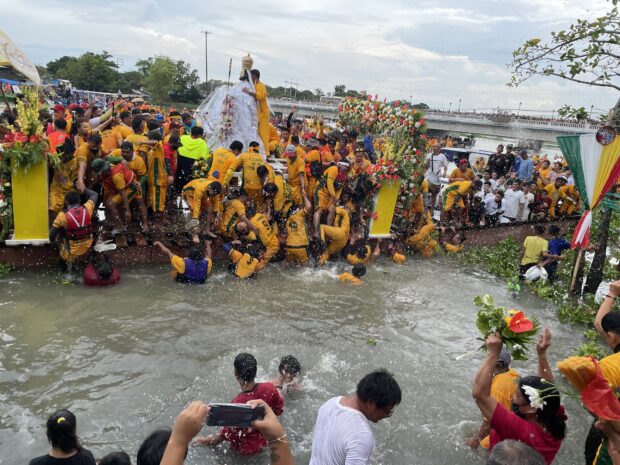
The libad (fluvial procession) of St. Peter, revered as Apung Iru in Apalit town, is among the oldest Catholic traditions in Pampanga. The townsfolk believe that the river takes lives (mangua bie) every time the three-day feast is held from June 28 to June 30. Photo by Tonette T. Orejas
CITY OF SAN FERNANDO, Pampanga — A boy drowned in Pampanga River while a fluvial procession was being held on Wednesday, June 28, during the twin feast of Saints Peter and Paul in Apalit town in Pampanga, the police confirmed on Thursday.
Jomar Manarang, 12, went missing around 1 p.m. after he swam with his friends along the Barangay Sucad section of the river while the libad (procession on water) was ongoing.
Local rescuers recovered him but he was declared dead on arrival in a hospital at 2:25 p.m., according to Lieutenant Colonel Michael Jhon Riego, town police chief, in a phone interview.
The incident bolstered the townsfolk’s belief that the river takes lives (mangua bie) every time the three-day feast is held from June 28 to June 30, Mayor Oscar Tetangco Jr. said.
“But I think it really is more a matter of being conscious of safety,” he added.
On June 28 last year, two men died and four others were injured from electrocution when their boat participating in the fluvial parade in this city hit a high-tension wire that belonged to the National Grid Corporation of the Philippines.
The fluvial parade was in its 179th year since 1844, but there is no official tally of incidents occurring in the previous decades.
Truck ban
During the three-day feast that began on Wednesday, the local government imposed a total truck ban along the Apalit segment of the Manila North Road (MacArthur Highway) to ease traffic congestion there.
The ban is in effect 24 hours a day, and drivers have been advised to use the North Luzon Expressway instead, increasing the truck operators’ cost of operation for fuel and tolls.
Catholic devotees also built a new pagoda for the libad, which has resumed for the second time since the COVID-19 pandemic forced a halt to the tradition in June 2020.
Tetangco said many Kapampangan from overseas have returned to join the devotional practices.
The rite would always begin in the private chapel of the Gonzales family in Barangay Capalangan. There, the Knights of St. Peter congregated and fetched the image by noon, or when it was believed to be less heavy.
Then the image of the first pope is to be carried on the new pagoda waiting at a small port near Barangay Gatbuca in nearby Calumpit town in Bulacan.
Pooled donations
The new pagoda, built on pooled donations and without a motor, was pulled by a tugboat borrowed from the Department of Public Works and Highways, according to Tetangco.
In the fluvial procession, boats tailed after the pagoda or encircled it. Devotees also threw out bottled water, eggs, biscuits, and candies.
Those on the banks waved leaves or dipped themselves in the river in the belief that the deed would wash away their ailments or sins.
For the event’s climax, the image of Apung Iru is brought to the parish church. The image is returned to its private chapel on the third and last day.
At least 180 cops, 115 force multipliers, and rescue personnel from 10 towns were deployed to secure the event, according to Colonel Levi Hope Basilio, Pampanga police director, in a phone interview.
The image of Apung Iru was first processioned in 1844 in a devotion begun by Pedro Armayan Espiritu, according to Toto Gonzales, one of the inheritors. Its face is made of ivory, while its staff, ring, and crown are coated in gold. It survived a fire in 2017. INQ
RELATED STORIES
2 dead, 4 hurt in Pampanga fluvial parade mishap – Inquirer.net
Fluvial parade resumes in Pampanga with fewer devotees